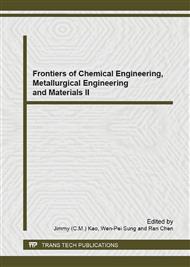p.113
p.118
p.122
p.127
p.131
p.137
p.142
p.145
p.149
Flotation Responce of the Refractory Yangla Copper Oxide Ores with Hydroxamate Collectors
Abstract:
To establish the flotation response and suitability of the collectors, series of bench-scale flotation tests are conducted for the refractory oxide copper ores obtained from Yangla Mine in Yunnan province. A simple xanthate (PAX) is used as the sulphide collector and a chelating reagent of hydroxamate AM28 as the oxide collector. It is found and confirmed by mineralogical examination that AM28 successfully recovered all the discrete copper oxide minerals from the Yangla ore. The flotation tests show that the overall copper recovery is affected due to the minerals copper associated with goethite which is not amenable to flotation. The average copper recovery from the rougher tests is 38.4% with a concentrate grade of 3.19%. The additional cleaning flotation can increase the Cu grade in concentrate further.
Info:
Periodical:
Pages:
131-136
Citation:
Online since:
September 2013
Authors:
Keywords:
Price:
Сopyright:
© 2013 Trans Tech Publications Ltd. All Rights Reserved
Share:
Citation:


